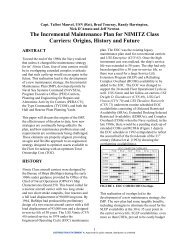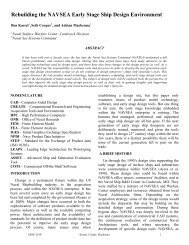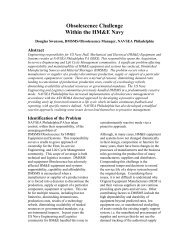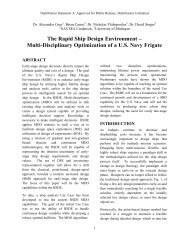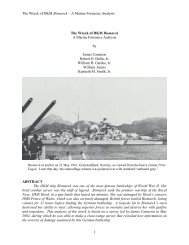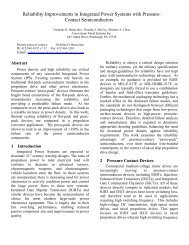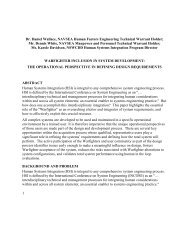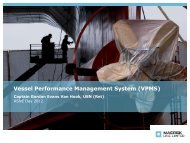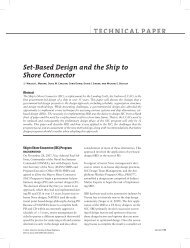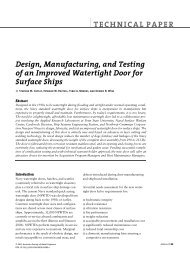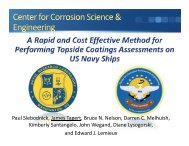Yendrey
Yendrey
Yendrey
Create successful ePaper yourself
Turn your PDF publications into a flip-book with our unique Google optimized e-Paper software.
Information Dominance;<br />
Anytime, Anywhere…<br />
Program Executive Office<br />
Command, Control, Communications,<br />
Computers and Intelligence (PEO C4I)<br />
C4I Common Capability Builds<br />
Statement A: Approved for public release; distribution is unlimited (19 FEBRUARY 2013)<br />
Art <strong>Yendrey</strong><br />
PEO C4I, PMW 770<br />
PEO SUB Liaison<br />
202-781-2415<br />
art.yendrey@navy.mil<br />
PEOC4I.NAVY.MIL
• Today, there are:<br />
Problem Statement<br />
Multiple unique configurations across ship classes and platforms<br />
Platform unique engineering / design costs<br />
• Disparate C4I platform configurations hamper:<br />
Interoperability<br />
Operational Effectiveness<br />
Configuration Management<br />
Logistic Support<br />
• PEO C4I Capability Build concept has been developed to reduce C4I<br />
variance within fleet platforms<br />
Spiraling Cost and reduced Platform Availability (Ao) drove a need for change<br />
• Fielding Capability Builds requires:<br />
Coordinated resource plan with OPNAV sponsors<br />
Common requirements and prioritized input from the fleet<br />
Close coordination with Ship Acquisition Program Managers (to align back fit<br />
modernization with new construction)<br />
A Capability Build bundles C4I products into end to end packages,<br />
and repeats across multiple ship classes<br />
2
Reducing Configuration Variances on Ship Classes<br />
Common Submarine Radio Room<br />
(CSRR) Background and Lessons<br />
Learned<br />
CSRR is now being installed on all Submarine Classes<br />
3
Introduction to CSRR<br />
CSRR is an integration of existing technology into an open IP based<br />
communications system<br />
• It does not develop new radios or antennas<br />
• It leverages Government programs of record to the maximum extent possible<br />
CSRR Operational View (OV-1)<br />
IP – Internet Protocol<br />
ILS – Integrated Logistics Support<br />
• Robust Design, Build, Test<br />
prior to fielding<br />
• Common training pipeline<br />
and ILS<br />
• Common Radios/Terminals<br />
• Common COMSEC<br />
• Control & Management<br />
based on common<br />
hardware and requirements<br />
• ADNS serves as common<br />
network interface<br />
• Common infrastructure for<br />
all platforms<br />
• Scalable for all platforms<br />
ADNS – Advanced Digital Network System<br />
COMSEC – Communications Security<br />
4
Payoff Seen with CSRR<br />
• CSRR program cost almost cut in half<br />
Total CSRR Program Cost: $ 853M<br />
Estimated cost to modernize 4 separate Submarine Class unique radio rooms:<br />
$1560M<br />
Estimated savings with common solution across all platforms: $707M<br />
• Installation costs for a block upgrade much less expensive<br />
Ex - 4 separate EC’s on SEAWOLF - $220K, but done as a block upgrade $70K<br />
• Common training<br />
All can use common MRTS trainer concept<br />
• Common ILS baseline for technical documentation<br />
Reuse much of the development efforts<br />
• Integration efforts build on each other<br />
Experience has show a 40% reduction between platforms for EC development<br />
• Common C&M software brought a significant reduction in build costs<br />
Ex - Implemented a single VIRGINIA C&M software upgrade with over 600<br />
software trouble reports fixed with no new Pri-1,2 or 3 issues<br />
• Operational Testing (OT)<br />
Successful OPEVAL of a CSRR baseline covers all Sub Classes<br />
EC – Engineering Change<br />
MRTS – Multipurpose Reconfigurable Training System<br />
C&M – Configuration Management Software<br />
SEAWOLF – SEAWOLF Class Submarine<br />
5
Common CSRR Trainer for all Subs /<br />
all CSRR baselines<br />
• Multipurpose Reconfigurable<br />
Training System (MRTS) : Hardware costs<br />
$500K vice $20M for each training set<br />
Software upgrades faster and less<br />
expensive<br />
– $2-4M/CSRR baseline for MRTS operator<br />
and maintenance software development<br />
– Can implement at as many sites as needed<br />
Allows teaching multiple CSRR baselines<br />
in same lab / school house<br />
– Once a baseline is developed it can be<br />
used until completely superseded in the<br />
Fleet<br />
CSRR MRTS trainers being put in place at<br />
Bangor WA, Kings Bay GA, Norfolk VA,<br />
Groton CT and Pearl Harbor HI<br />
• Virtual displays of equipment projected<br />
on touch-screen displays<br />
• Virtual CSRR responds as actual<br />
CSRR baseline would respond<br />
• Trainer can shift to different CSRR<br />
baseline or different Submarine Class<br />
configuration in minutes<br />
6
Keys to Success<br />
• Agreement by all stakeholders on requirements<br />
• Configuration Control<br />
Class alterations and drawings – pay once, not for every ship<br />
• Shore based integration labs and testing<br />
System of systems tested / validated ashore<br />
All external interfaces confirmed operational prior to delivery<br />
Documentation validated and verified ashore<br />
Logistics and MRTS training finalized to support initial installation<br />
• New Construction: Manage GFI at the rack level (or larger) and<br />
not at the component level<br />
GFI needed 6-12 years before ship goes to sea<br />
Establish and live within space, weight, power and cooling limits for racks<br />
Keep total flexibility to change equipment inside racks up to day of<br />
delivery<br />
• Implications:<br />
System works better at delivery<br />
– Ex - First crew commenced OPEVAL after 7 days at sea<br />
– Ex - Ship deployed on mission after 12 underway days per crew<br />
GFI – Government Furnished Information<br />
OPEVAL – Operational Evaluation<br />
7
Reducing Configuration Variances on Ship Classes<br />
C4I Capability Builds<br />
Background and Strategy<br />
Building on Lessons Learned from CSRR<br />
8
C4I Capability Builds<br />
The Builds Rationale<br />
• C4I Capability Builds are the basis for achieving standard<br />
baselines across platforms<br />
Builds consist of plans for each class to consistently field C4I<br />
systems during two year increments across the FYDP<br />
New construction deliveries aligned to Builds provide up to date<br />
systems that don’t introduce variation<br />
• Reduced variation enables:<br />
Better system integration and<br />
test prior to installation<br />
Standard installation & Support<br />
packages<br />
Reductions in sustainment /<br />
support costs (Program/Fleet)<br />
Network and Applications<br />
Program Variant/Version<br />
CANES AN/USQ-208(V)1 CANES HW v1<br />
CANES AN/USQ-208(V)1 CANES SW v1<br />
ADNS AN/USQ-144K(V)2 ADNS Inc III/ SP1/ SP2/ SP3 /SP4<br />
GCCS-M V4.1<br />
NTCSS Patriot (P2)/ Patriot (P3)/ Open Architecture (OA) Release 2<br />
NAVMACS AN/SYQ-26(V)7 NAVMACS II Tech Refresh<br />
MFOM v2.1 (Maintenance and CASREP Toolboxes)<br />
Network and Applications<br />
Common Radio Room<br />
Warfare Support<br />
Signals Exploitation<br />
Common Radio Room*/Bandwidth<br />
Program Variant/Version<br />
NMT AN/WSC-9(V)2 NMT (Q/X/Ka)<br />
NMT ATIP<br />
NMT SATCOM Split IP<br />
GBS AN/USR-10A(V)7<br />
CRYPTO KIV-7M COMSEC Serial Crypto Replacement<br />
CRYPTO VACM<br />
UHF IW MD 1324A w/IW<br />
DMR DMR 6.4.x<br />
JTIDS AN/URC-107 4.11<br />
BFTN AN/USQ-195(V)1 or BFTN(e)<br />
ISSP EKMS Phase 5 or KMI Q1FY15<br />
Program<br />
Warfare Support<br />
Variant/Version<br />
CDLMS CDLMS 3.8<br />
NAVSTAR GPS NAVSSI 4.2.0 or NAVSSI 4.2.1<br />
NAVSTAR GPS<br />
NAVSSI 4.2.0.55R2 or 4.2.0.56 or<br />
4.2.1.97R3<br />
NAVSTAR GPS SEA NAVWAR ADAP<br />
JTT-M AN/USQ-151 Block 6<br />
Signals Exploitation<br />
PEO C4I Goal 1: Minimize total ownership cost, while delivering<br />
integrated C4I capabilities<br />
9
C4I Capability Builds<br />
Variance Reduction Analysis<br />
• Analyzed configuration of 8 major C4I Capability Build<br />
systems on DDG 51 Platforms:<br />
Network & Applications<br />
• CANES / ISNS Variants<br />
• ADNS Variants<br />
• GCCS-M S/W Variants<br />
Common Radio Room<br />
• NMT / EHF FOT Variants<br />
• WSC-6 SHF Variants<br />
• GBS Variants<br />
• Commercial SATCOM Variants<br />
Signals Exploitation<br />
• SSEE & legacy intel<br />
Variants<br />
# Platforms or # Unique Configurations<br />
80<br />
70<br />
60<br />
50<br />
40<br />
30<br />
20<br />
10<br />
0<br />
Introduction of new<br />
Build System<br />
# DDG Configurations<br />
# In-Service DDGs<br />
FY11 FY12 FY13 FY14 FY15 FY16 FY17 FY18 FY19 FY20<br />
Builds will reduce platform variation over time<br />
through modernization<br />
Red Bars:<br />
# of In-Service<br />
Platforms<br />
Blue Bars:<br />
# of Unique Configs,<br />
aggregating all 8<br />
systems<br />
10
PEO C4I/Fleet Approved<br />
C4I Capability Builds<br />
Defined<br />
C4I Builds FY14-15<br />
Pilot: Whole Builds to DDG 51 Platform<br />
Build Architecture and<br />
Integrated Systems Design<br />
CANES<br />
Signals Exploitation<br />
Multiple<br />
Interfaces to<br />
all Builds<br />
Networks & Apps Warfare Support<br />
TA-970 /<br />
PICT<br />
Freq Std,<br />
QMCS,<br />
Voice Rcdr<br />
Tactical<br />
Variant<br />
Switch<br />
(TVS)<br />
AIS<br />
SSR-1 /<br />
HSFB<br />
Common Radio Room (CRR)<br />
Training & logistics pkgs<br />
Installation & Test pkg<br />
Integrated, tested &<br />
verified prior to install<br />
ANT<br />
ANT<br />
SEA NAVWAR<br />
ADAP<br />
AN/SSQ-130(V)<br />
SSEE INC F<br />
PMW 120<br />
CANES<br />
GUARD<br />
PMW 160<br />
AIS<br />
PMW 120<br />
ANT<br />
OTHER<br />
SYSTEMS<br />
CANES<br />
GUARD<br />
PMW 160<br />
OTHER<br />
SYSTEMS<br />
OTHER<br />
SYSTEMS<br />
GPS<br />
NAVSSI 4.x or<br />
G-PNTS<br />
PMW 170 TO SYSTEMS<br />
THAT REQUIRE<br />
TIMING & NAV<br />
Legend<br />
CRR Build<br />
Apps on CANES<br />
GCCS-M 4.1<br />
NTCSS Eagle / OA<br />
MFOM v2.0<br />
DDG Only<br />
ECDIS-N<br />
EMIO<br />
PMW 160<br />
Networks Build<br />
Warfare Support<br />
Systems Build<br />
Signals Exploitation<br />
Build<br />
Defined, integrated, tested and verified C4I CBs<br />
Pilot FY FY 14/15 14/15 Group (e.g. C4I DDG) CB Allocated (Network/CRR) Architecture on Destroyer<br />
PMW 160<br />
CANES SCI<br />
CANES OSE<br />
CND<br />
GCCS W/MTS<br />
(PMW 150)<br />
VAR HOSTED APPS<br />
AN/USQ-171(V)5<br />
SCI VTC<br />
EMBARKED<br />
COMMANDS<br />
FILE<br />
PCs /<br />
SERVERS /<br />
PRINTERS<br />
STORAGE<br />
CANES SECRET<br />
CANES OSE<br />
CND<br />
GCCS W/MTS<br />
(PMW 150)<br />
DMS PROXY<br />
VAR HOSTED APPS<br />
EMBARKED<br />
COMMANDS<br />
FILE<br />
PCs /<br />
SERVERS /<br />
PRINTERS<br />
STORAGE<br />
CANES<br />
UNCLASSEIFIED<br />
CANES OSE<br />
CND<br />
NTCSS (PMW 150)<br />
VAR HOSTED APPS<br />
WIRELESS<br />
PC<br />
EMBARKED<br />
COMMANDS<br />
FILE<br />
PCs /<br />
SERVERS /<br />
PRINTERS<br />
STORAGE<br />
CANES COALITION<br />
PT<br />
RTR<br />
MULTIPLEXER<br />
(BACKUP)<br />
FRD<br />
AN/USQ-144K(V)2 ADNS K(III)<br />
PMW 160<br />
PT<br />
RTR<br />
PT<br />
RTR<br />
PT<br />
RTR<br />
FOR AMPHIBIOUS<br />
SHIPS ONLY<br />
SI<br />
COMM SUITE<br />
PACKET SHAPER<br />
AED<br />
PACKET SHAPER<br />
AED<br />
PACKET SHAPER<br />
AED<br />
ANT<br />
AN/SYQ-26(V)7<br />
NAVMACS II<br />
TECH REFRESH<br />
PMW 790<br />
AN/USQ-<br />
195(V)1 BFTN<br />
PMW 170<br />
SNR<br />
PMW 170<br />
CT<br />
ROUTER<br />
w/CEM<br />
ADNS<br />
MAGTF<br />
PMW 160<br />
FY14-FY15 DDG C4I BUILD ARCHITECTURE<br />
NAVAIR<br />
TACTICAL<br />
VOICE<br />
TERMINALS<br />
RED<br />
CONFERENCE<br />
SWITCH<br />
(TVS)<br />
RED<br />
TACTICAL<br />
SWITCH<br />
(TVS)<br />
FRD<br />
APTS<br />
NEX COM<br />
NAVAIR<br />
INTERIOR<br />
COMMS<br />
AN/USQ-155<br />
TVS<br />
CRYPTOs<br />
PMW 130<br />
FRD<br />
AN/USQ-155(V)<br />
TVS CONTROL<br />
FRD<br />
CRYPTOs<br />
PMW 130<br />
HF IP / SNR<br />
MODEMs<br />
PMW 170<br />
BLACK<br />
MATRIX<br />
SWITCH<br />
(TVS)<br />
RCV Only<br />
PMW 150<br />
AEGIS N+1<br />
C&D BACKUP<br />
NGC2P / CDLMS<br />
PMW 150<br />
AEGIS C&D<br />
LINK 11 KG-40<br />
PMW 150<br />
INE<br />
PMW 130<br />
CRYPTOs<br />
PMW 130<br />
SSQ-89<br />
NAVSEA<br />
ANT<br />
FRD<br />
AN/SCR-60<br />
EPLRS-DR<br />
FRD<br />
FRD<br />
PMW 170<br />
TX<br />
Only<br />
TD-1271,<br />
MD-1324,<br />
MD-1324A<br />
FRD<br />
TIP (AEHF)<br />
PMW 170<br />
INTERIOR<br />
STEs<br />
COMMS<br />
PMW 130<br />
SCIP-IWF<br />
NAVSEA<br />
PMW 160<br />
ELECTRONIC KEY<br />
VARIOUS<br />
MANAGEMENT<br />
SERIAL<br />
SYSTEM (EKMS)<br />
CRYPTOs<br />
APPS<br />
PMW 130<br />
CRYPTO<br />
PMW 130<br />
CRYPTO<br />
PMW 130<br />
CRYPTO<br />
PMW 130<br />
INE<br />
PMW 130<br />
CRYPTO<br />
PMW 130<br />
AN/USC-61<br />
ANT<br />
(HF DAG)<br />
PMW 170<br />
USC-61 (UHF/VHF LOS ANT<br />
RADIO)<br />
PMW 170<br />
ANT<br />
AN/URC-141C MOS<br />
PMW 150<br />
USC-61<br />
UHF IW SATCOM<br />
PMW 170<br />
ANT<br />
OE-570A<br />
FRD<br />
RF<br />
SWITCH<br />
AN/USQ-151<br />
JTT<br />
PMW 120<br />
ANT<br />
AN/SSR-1A<br />
FRD<br />
AN/WSC-9(V)2<br />
EBEM AES NMT (X/Ka/Q)<br />
PMW 170<br />
ANT<br />
AN/USC-69(V)3<br />
CBSP ULV<br />
EBEM AES<br />
PMW 170<br />
AN/USR-10<br />
GBS<br />
W/SPLIT IP<br />
PMW 170<br />
PIER<br />
CONNECTIVITY<br />
PMW 160<br />
AEHF<br />
ANT<br />
SHF<br />
ANT<br />
ANT<br />
DDG 51 Pilot - FY 15 CNO Avail<br />
* Not an "officially" designated<br />
formal test effort<br />
Measurable Results:<br />
•Repeatable process<br />
•Integrate &Test once,<br />
deliver to many<br />
•Integrated installation and<br />
test packages<br />
•Optimized logistics support<br />
and training delivery<br />
•Reduced Variance and TOC<br />
11
PEO C4I Proposal<br />
Available C4I<br />
Capability Builds<br />
(FYDP - 3 baselines)<br />
C4I Capability Builds<br />
Definition Validation Process<br />
Platform Requirements FFC N6 / PACFLT N6 /<br />
Validation Group: FCC Deputy (Tri-Chair)<br />
N2N6 E, F1, F2, F3, F4 Advisory:<br />
CNAF/AIRLANT SPAWAR 5.0<br />
SURFOR/SURFLANT PEO C4I, Ships, Subs<br />
SUBFOR/SUBPAC PEO Aircraft Carriers<br />
CYBERFOR<br />
N95B, N96B, N97B, N98B<br />
Builds<br />
Implementation Fleet<br />
Working Group<br />
(NCMC ESG)<br />
FLAG Level Board of Directors- N2N6F / N9I (Co-Chair)<br />
N95 DASN C4I<br />
N96 FFC N6<br />
N97 CPF N6<br />
N98 FCC Deputy<br />
Proposed C4I<br />
Capability Builds<br />
Integrated Program Fielding Plans<br />
Variance Reduction Board held 20 December, 2012 – Final results pending<br />
Validated C4I<br />
Capability Builds<br />
Resourced<br />
C4I Capability<br />
Builds<br />
12
Summary<br />
• PEO C4I Capability Build strategy has been<br />
developed out of a necessity to reduce C4I variance<br />
within fleet platforms<br />
Reducing cost and improving platform Ao are major drivers<br />
for change<br />
• Fielding C4I Capability Builds by platform requires:<br />
Ao - Availability<br />
Coordinated resource plan<br />
Prioritized input from the Fleet<br />
Close coordination with Ship Acquisition Program<br />
Managers (SHAPM)<br />
13
We get IT.<br />
We also integrate it, install it and<br />
support it. For today and tomorrow.<br />
Visit us at www.peoc4i.navy.mil<br />
14



